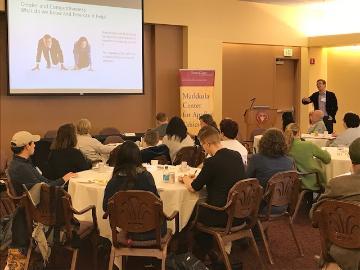
Sparking Transformative Solutions
Several high-profile businesses headquartered in Silicon Valley have recently come under scrutiny for their diversity and inclusion practices (or lack thereof). So what are some tangible steps businesses can take to improve the diversity of their organizations? Academic research can be a guide.
It can be a struggle to convert abstract research in academic journals into tangible action items or tools for organizations. The Science of Diversity and Inclusion Initiative (SODI), housed at the University of Chicago’s Economics Department, aims to bridge the gap between research and companies by bringing them together in a “living laboratory” to “design, test, and scale new models that accelerate diversity, inclusion, and belonging.”
On March 9, 2018, SODI co-founders, Jeffrey Flory and Kara Helander, presented new and existing diversity and inclusion research to a group of scholars, businesspeople, community members, and students at Santa Clara University as part of the Markkula Center’s Workplace Diversity Dialogues. Their findings focused on three important research highlights: competition, assignments and advancement, and hiring attraction and selection.
Competition
Research shows that highly competent women self select-out of competition while incompetent men select into competition, something we commonly refer to as “the gender gap.” In addition to this gap, competition-based incentives can actually push away highly skilled women and attract lower skilled men.
The gender gap disappears when companies do the following:
- Base pay on performance of a group or team rather than the individual
- Lessen the amount of pay that relies on an individual’s performance relative to coworkers
- De-emphasize the importance of competition between colleagues and, instead, focus on self-improvement and compare teams/pairs rather than individuals
Assignments & Advancements
Research shows that men are more likely to perform high-promotability tasks (like revenue or research generating projects) while women are more likely to perform low-promotability tasks (like note taking in meetings, planning office celebrations, etc.), which has detrimental implications for women during the promotion process and can stifle their advancement in organizations.
To help assign tasks equitably, companies should:
- Randomly assign low-promotability work tasks.
- Track who performs what task and then assign tasks more equitably across employees
- Explicitly discuss this problem in the workplace by bringing attention to the task differential and asking employees to be aware of it when they volunteer or assign tasks
Hiring: Attraction and Selection
Research suggests that explicit diversity messages in job postings attract high quality candidates, particularly high quality minority candidates. When diversity messaging on the application came from the CEO, application rates saw the largest increase. These findings imply that demonstrated diversity buy-in from leadership is important to attracting high quality candidates.
To attract high quality and diverse candidates, companies should:
- Explicitly emphasize diversity in job postings. Messaging can tie the value a company places on diversity to competitive advantage and productivity and/or show how diversity is part of the company’s overall culture.
- Have this message come from company leadership
For a detailed breakdown of the above research findings, their implications, and actionable recommendations, see Flory and Helander’s presentation slide deck.
Interview with the Co-Founders of the Science of Diversity and Inclusion Initiative
Jeffrey Flory and Kara Helander talk with Ann Skeet, Senior Director of Leadership Ethics at the Markkula Center for Applied Ethics, about SODI and their findings.
